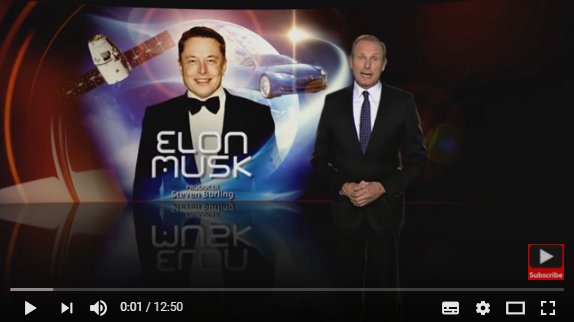As the world prepares for Elon Musk’s
much-anticipated Tuesday, September 27th, 2016 speech at the 2016 International Astronautical Congress (IAC 2016), where he will outline his plan to settle
Mars, a look back at SpaceX’s history is in order.
An inventory of the
company’s wins and losses can provide some perspective on the ambitious goals
ahead:
- June 1st, 2002 - Space Exploration Technologies Corporation, better known as SpaceX is founded by Elon Musk in El Segundo, California. The company is later relocated to Hawthorne, California.
- March 1st, 2006 - CEO Musk invests $100Mln US ($132Mln CDN) of his own money into SpaceX.
- June 4th, 2010 - The SpaceX Falcon 9 rocket completes its maiden flight after launch from Kwajelin Atoll, part of the Republic of the Marshall Islands (RMI).
- December 8th, 2010 - A SpaceX Dragon capsule orbits Earth then safely crashes into Pacific Ocean making it the first commercial spacecraft to do so.
- April 5th, 2011 - SpaceX reveals its plans for the FalconHeavy rocket.
- May 25th, 2012 - The SpaceX Dragon capsule becomes the first private spacecraft to dock with the International Space Station (ISS).
- October 8th, 2012 - SpaceX completes its first resupply mission (CRS-1) to the ISS using its Dragon spacecraft. It's the first private spacecraft to do so and delivers 1,000 pounds of cargo.
- December 17th, 2012 - SpaceX completes a successful 12-story test flight of its Grasshopper rocket. The Grasshopper is a reusable rocket whose first stage is designed to fly back to Earth, refuel and fly again.
- March 9th, 2013 - SpaceX completes a successful 24-story test flight of the Grasshopper.
- October 7th, 2013 - SpaceX completes its 8th and final test flight of the Grasshopper. It reaches 2441 feet and lands successfully. The vehicle is then retired but the knowledge collected from the flights, and the soft landings, are integrated into the Falcon-9 design.
- April 14th, 2014 SpaceX sues the US Air Force for the right to compete for national security payload launches, then a monopoly of UnitedLaunch Alliance (ULA).
- September 16th, 2014 SpaceX signs an agreement with NASA to be first US commercial company (along with Boeing) to launch astronauts to ISS.
- January 16th, 2015 - A SpaceX Falcon 9 first stage landing attempt on a drone ship during the fifth cargo resupply mission (CRS-5) mission to the ISS fails. The failure is traced to a loss of hydraulic fluid just before touchdown.
- January 23rd, 2015 - The US Air Force agrees to certify SpaceX rockets for national security launches and SpaceX drops its April 14th, 2014 lawsuit. SpaceX is certified for national security launches on May 26th, 2015 and ULA’s monopoly on launching national security payloads is broken.
- April 24th, 2015 - SpaceX's second Falcon 9 1st stage landing attempt on a drone ship during CRS-6 mission to ISS fails. The rocket tipped over on landing due to excess lateral velocity.
- June 28th, 2015 - A Falcon 9 rocket explodes during the seventh SpaceX cargo resupply mission (CRS-7) launch to the ISS and the Dragon spacecraft is lost. The cause was traced to the failure of a strut which secured a high-pressure helium bottle inside the second stage's liquid oxygen tank, causing it to over pressurize and burst.
- December 21st, 2015 - A Falcon 9 rocket makes a historic landing on land at Cape Canaveral after it delivers eleven satellites into orbit. "I do think it's a revolutionary moment. No one has ever brought an orbital class booster back intact," SpaceX founder and CEO Elon Musk told reporters in a teleconference after the launch and landing success.
- January 17th, 2016 - The third Falcon 9 first stage landing attempt on a drone ship fails. The landing legs didn't lock and the rocket simply fell over after landing.
- March 4th, 2016 - A fourth Falcon 9 first stage landing attempt on a drone ship fails. The rocket landed hard, fell over and exploded.
- April 8th, 2016 - The fifth Falcon 9 first stage landing attempt on a drone ship finally succeeds.
- April 26th, 2016 SpaceX announces they will relaunch a recovered Falcon 9 rocket later in the year and its first crewed mission to ISS in 2017 or early 2018.
- April 28th, 2016 - SpaceX tweets they will send a non-crewed Red Dragon to Mars as early as 2018 in preparation for human landings.
- April 28th, 2016 - SpaceX is awarded its first national security launch contract to launch the USAF's GPS-3 satellite. But SpaceX won competition by default as ULA declined to bid.
- September 1st, 2016 - A Falcon 9 rocket explodes on the pad at Cape Canaveral. The rocket was due to launch the Israel built Amos 6 communications satellite for Facebook.
- September 23rd, 2016 - SpaceX releases the initial results of its investigation, which reveal that it believes a breach in the helium system in the Falcon 9's liquid oxygen system caused the explosion. The investigation continues as SpaceX says it wants to resume launches in November 2016.
It's worth noting that, while many of the points listed above came originally from the April 26th, 2016 Techcrunch post, "A Brief History of SpaceX," the future of the company is still very much to be written by Musk, and by others.
Here's wishing them the best.
 |
| Brian Orlotti. |
Brian Orlotti is a regular contributor to the Commercial Space blog.


No comments:
Post a Comment